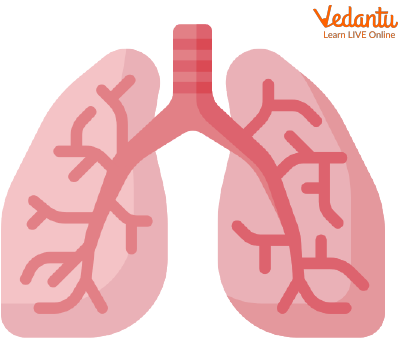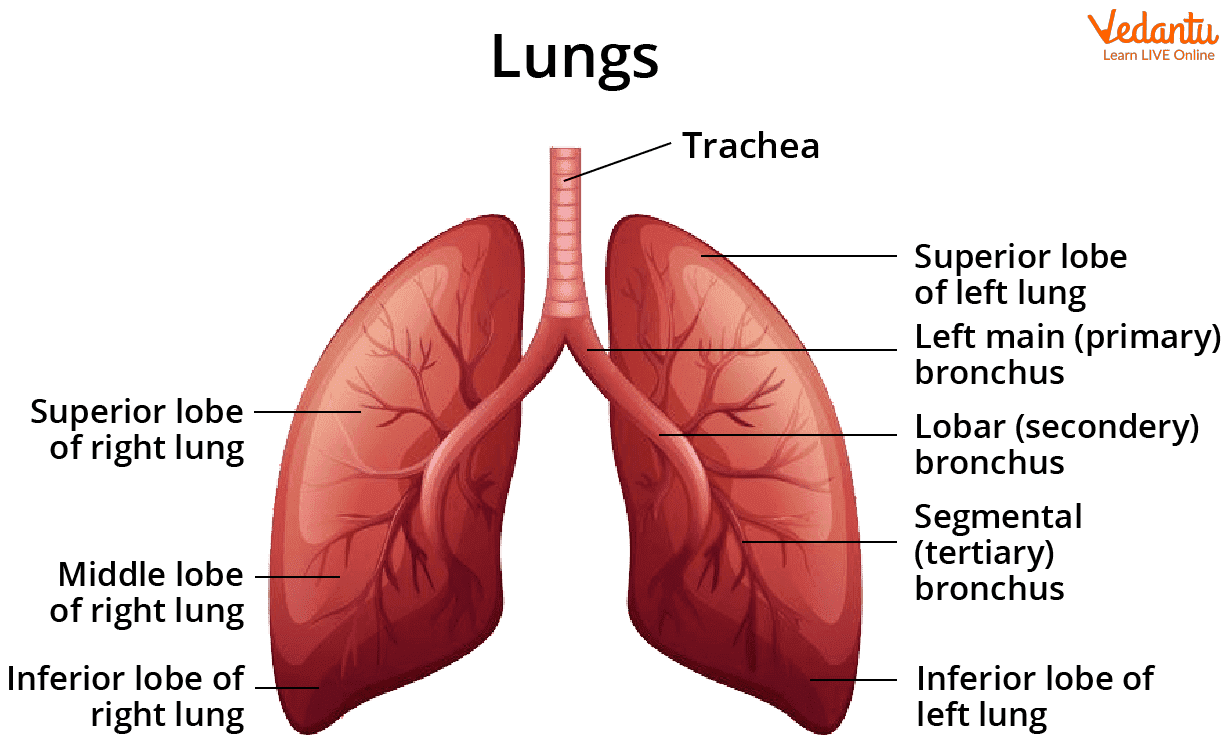




Human Lungs With Diagram
The lungs and respiratory system work together to allow us to breathe fresh air, expel stale air, and even talk. Let's go on a journey learning about the lungs!
Lungs are bag-like organs or body parts that allow you to breathe. They are a part of the respiratory system of the human body. Lungs are found in all animals that have a backbone and breathe air. When an animal inhales (breaths in), oxygen-rich air enters the lungs. Carbon dioxide and water vapour are ejected from the lungs when an animal exhales (breaths out).
Structure and Simple Lungs Diagram
One on each side of the chest, a human body has two lungs. Between the lungs is where the heart is located. The lobes of the right lung are three rounded sections. The left lung is divided into two lobes. The diaphragm is a strong muscle sheet that rests at the base of each lung. The diaphragm and the rib muscles automatically tighten and relax during normal breathing. This movement aids in the filling and emptying of the lungs.

Left and Right Lobes of the Lungs
A series of tubes transport air into and out of the lungs. The trachea, or windpipe, is a large, tough tube that connects the top of the throat to two branching tubes called bronchi. Each of these tubes connects to a different lobe of the lungs. The bronchi are then divided into bronchioles, a web of smaller tubes. The bronchioles branch off into tiny sacs known as alveoli.

Human Lungs
Lungs for Kids
The lungs weigh roughly 40 grams at birth and double in size after 6 months. The alveoli are small air sacs located at the end of the bronchioles (tiny branches of air tubes in the lungs). The alveoli are the air sac spaces between the lungs and the blood where oxygen and carbon dioxide are exchanged during breathing in and out. Mature pulmonary alveoli begin at 36 weeks of pregnancy and continue to develop until the child is roughly 2 years old. By the age of two, when most of the alveolarisation process has been finished, the total lung weight is around 170 g.
Working of Lungs
When you inhale (breathe in), air enters your lungs and transports oxygen to your blood. Simultaneously, carbon dioxide, a waste gas, travels from your blood to your lungs and is exhaled (breathed out). This process, known as gas exchange, is required for life to exist, which is how the lungs work.
Importance of Lungs
To live, every cell in a body requires oxygen. The air breathed contains oxygen and other gases. When oxygen reaches the lungs, it is carried through the body via the bloodstream. Gas exchange is a necessary process that the lungs and respiratory system carry out on their own.
Lung Infections
Coughing, chest pain, and difficulty breathing are common symptoms of lung problems. Pneumonia and tuberculosis are both serious lung infections. Emphysema and lung cancer are both fatal lung diseases. One of the leading causes of emphysema and lung cancer is smoking.
Interesting Facts About Lungs
The lungs are the most important part of the respiratory system in the human body.
The lungs take in oxygen from the air and expel carbon dioxide.
The lungs transport oxygenated blood (oxygen-rich blood flows from the lungs) to the heart while removing carbon dioxide from the bloodstream.
Humans can vocalise sounds and speak, thanks to their lungs.
The lower respiratory tract includes the human lungs. The nose or nostrils, nasal cavity, mouth, throat (pharynx), and voice box are the major passages and structures of the upper respiratory tract (larynx).
Every 24 hours, an average healthy person will breathe around 2,900 gallons of air.
The lungs have a dome-shaped diaphragm (a thin skeletal muscle) to inhale and expel air.
To create room for the human heart, the left lung is smaller than the right lung.
The upper lobe, middle lobe, and lower lobe are the three lobes of the right lung.
The upper and lower lobes of the left lung are divided into two sections.
The left lung of a female human weighs between 105–515 g, while the right lung weighs between 100–590 g.
The right lung of a human male weighs between 155–720 g on average, whereas the left lung weighs between 110–675 g.
There are approximately 1,500 miles of airways in both human lungs.
Summary
Everybody component requires oxygen from the air a human breathes to survive. The lungs' fragile structure is responsible for breathing and delivering oxygen to the rest of the body. At the same time, it aids in the defence of the body against external threats.
FAQs on Lungs Diagram
1. What is the most common cause of a lung infection?
Pneumonia is a lung infection that leads the air sacs in one or both lungs to become inflamed. The most common cause of pneumonia, which affects the lungs' smaller air sacs, is contagious bacteria, though a virus can also do so. A person becomes infected by breathing in the bacteria or virus from infected individual sneezes or coughs. Lung infections, such as pneumonia, are typically mild, but they can be severe, particularly in people with compromised immune systems or chronic conditions such as chronic obstructive pulmonary disease (COPD).
2. Explain the mechanism of breathing.
Breathing is inhaling oxygen (O2) into the lungs and exhaling carbon dioxide (CO2) from the body. Human breathing mechanisms are similar to those of animals. Plants process respiration and vice versa. As previously stated, breathing rates vary from person to person, ranging from 15 to 18 times per minute. When it comes to understanding the mechanism of respiration, air pressure is crucial. The lungs' alveolar spaces actively take in the air during inspiration; when the pressure inside the lungs exceeds the pressure of the atmosphere, the oxygen is expelled as carbon dioxide during expiration.
3. Can a lung grow back?
No, the lungs can't regenerate. You can take out 75% to 80% of the liver, which will regenerate, but not the lungs. After a lobectomy, your mediastinum (a space in the thorax in the middle of the chest) and diaphragm will shift a little, so there won't be a space left where the lobe was taken out.
4. Where are lungs located?
Lungs are located in the thoracic cavity, which is also known as the chest cavity.









